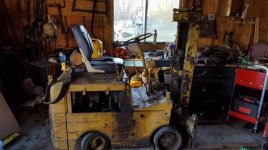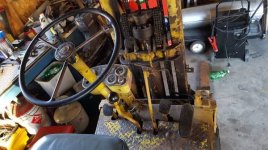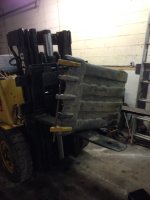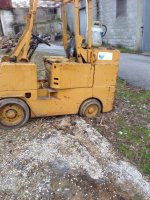SteveJ
New member
- Joined
- Jan 16, 2007
- Messages
- 17
- Location
- Silver Lake, MI
- Tractor
- Massey Ferguson 3018M, Kubota B6100, Kubota B7300
This is my first posting, so I hope I am doing it correctly and in the right place. I bought a Clark Clipper forklift last fall. I only paid $550 for it running, but when it wouldn't start last month, my wife still made some snide comments about the "junk" I buy. I had to agree, but the difference was I could afford this and couldn't afford a good forklift. I plan to try to figure out why it won't start, but have not had the time. It turns over, just won't catch, and the wiring on it is all over the place, with lots of wires not hooked to anything. It is an old one, probably from the 50's, but started and ran decently, the hydraulics worked, and while it seeped fluids, there were no leaks under it. What more can you ask for at $550?
I started to think about how I could show my wife it was a good deal. I came up with the concept of using the mast and making it into a log splitter, but can't find any information on doing so. It is a 2 Ton lift, but I can't believe that a 2 Ton lift would not be roughly equivalent to a 10 Ton log splitter. I just don't know how a log splitter tonnage is calculated versus a fork lift capacity. I also have to find out if I can pull the pump off the forklift and run it with a 2 HP electric motor. I would not be surprised to find the pump is integral to the engine and will not stand alone as something I can hook up to a an electric motor. The mast tilts, but no down pressure on the lift cylinder, which has an 8' lift. I have thought about turning the mast upside down and using s spring to pull it up, or using the tilt cylinders (or at least the controls) to pick up the head. Then I saw someone else's project and thought about laying the mast on its side and using the extra control with a larger cylinder as a log lift. Never having built one, it is all in my mind right now and I have a all the possibilities in the world. I just need some education in order not to do something stupid, or build it all and find out it won't work. Then I will be in even more trouble. I thought that if I can get the engine running again, I can clamp a 3" angle iron on to something and bolt a splitting wedge to it, and then just use the up controls to see if it will split a log. Not fancy, but it would be a proof of concept. Everything else would just be making it easier to use. Since I can't find any research on the subject, that is about what I am down to trying.
I retire in 20 months, so this is probably a retirement project. I am only home on the weekends right now and have lots to do on my time there. I have hundreds of state acreage that backs up to my property that I can get down logs from with no problem, so I'll have a ready access to wood and a splitter would be nice. If this is not a reasonable project, then I just sell the forklift, if I can get it running, or scrap it if I can't. I have a battery powered pallet stacker that is more useful in my small shop. I move last year and needed something so I could load with one of them at one end and a second lift to unload with at the other end. The pallet stacker is a 1,000 pound lift capacity with a 10 foot lift. I just pull it around like a wagon, and it will fit in my 24 x 32 shop much better than an actual forklift. With a table saw that weights 600 pounds, and other things like that, some type of indoor lifting and moving capacity is a great thing to have. My wife criticized the pallet stacker, until she realized that having it meant she was not on the other end of moving the tools. I used it to pick up crates while moving that were well over a ton, but was very careful picking them up and moving them. A couple of times it was picking up the back end and I had to unload stuff from the crates to be able to pick them up. I had the 26,000 GVW Penske truck I rented leaning to one side and couldn't do over 35 MPH on any hill, and they are not very big in central MI.
Any help that you can give me on the hydraulic issues and/or the project in general would be greatly appreciated. Once I know where to go with this, I can be on the lookout for a standalone pump and anything else I might need if I pursue the project and then start on it after April 2018 when I retire. If I can do this for a couple of hundred, using the forklift and used or surplus parts will justify the forklift purchase with no problem. Once I have the fireplace putting out the heat and ambiance that my wife wants, she will be happy that I bought the thing. She didn't talk to me for three weeks when I bought the Kubota tractor, but when I was using it to move rocks to make her rock garden and fill it with dirt, she commented that it was a good thing we bought it. Once I can use the tools for something she wants, then all is forgiven.
 If I added the pictures correctly, you can see that the forklift is not a thing of beauty. Never having added pictures previously, I'm not sure if I did it correctly.
If I added the pictures correctly, you can see that the forklift is not a thing of beauty. Never having added pictures previously, I'm not sure if I did it correctly.
Thanks for the help.
I started to think about how I could show my wife it was a good deal. I came up with the concept of using the mast and making it into a log splitter, but can't find any information on doing so. It is a 2 Ton lift, but I can't believe that a 2 Ton lift would not be roughly equivalent to a 10 Ton log splitter. I just don't know how a log splitter tonnage is calculated versus a fork lift capacity. I also have to find out if I can pull the pump off the forklift and run it with a 2 HP electric motor. I would not be surprised to find the pump is integral to the engine and will not stand alone as something I can hook up to a an electric motor. The mast tilts, but no down pressure on the lift cylinder, which has an 8' lift. I have thought about turning the mast upside down and using s spring to pull it up, or using the tilt cylinders (or at least the controls) to pick up the head. Then I saw someone else's project and thought about laying the mast on its side and using the extra control with a larger cylinder as a log lift. Never having built one, it is all in my mind right now and I have a all the possibilities in the world. I just need some education in order not to do something stupid, or build it all and find out it won't work. Then I will be in even more trouble. I thought that if I can get the engine running again, I can clamp a 3" angle iron on to something and bolt a splitting wedge to it, and then just use the up controls to see if it will split a log. Not fancy, but it would be a proof of concept. Everything else would just be making it easier to use. Since I can't find any research on the subject, that is about what I am down to trying.
I retire in 20 months, so this is probably a retirement project. I am only home on the weekends right now and have lots to do on my time there. I have hundreds of state acreage that backs up to my property that I can get down logs from with no problem, so I'll have a ready access to wood and a splitter would be nice. If this is not a reasonable project, then I just sell the forklift, if I can get it running, or scrap it if I can't. I have a battery powered pallet stacker that is more useful in my small shop. I move last year and needed something so I could load with one of them at one end and a second lift to unload with at the other end. The pallet stacker is a 1,000 pound lift capacity with a 10 foot lift. I just pull it around like a wagon, and it will fit in my 24 x 32 shop much better than an actual forklift. With a table saw that weights 600 pounds, and other things like that, some type of indoor lifting and moving capacity is a great thing to have. My wife criticized the pallet stacker, until she realized that having it meant she was not on the other end of moving the tools. I used it to pick up crates while moving that were well over a ton, but was very careful picking them up and moving them. A couple of times it was picking up the back end and I had to unload stuff from the crates to be able to pick them up. I had the 26,000 GVW Penske truck I rented leaning to one side and couldn't do over 35 MPH on any hill, and they are not very big in central MI.
Any help that you can give me on the hydraulic issues and/or the project in general would be greatly appreciated. Once I know where to go with this, I can be on the lookout for a standalone pump and anything else I might need if I pursue the project and then start on it after April 2018 when I retire. If I can do this for a couple of hundred, using the forklift and used or surplus parts will justify the forklift purchase with no problem. Once I have the fireplace putting out the heat and ambiance that my wife wants, she will be happy that I bought the thing. She didn't talk to me for three weeks when I bought the Kubota tractor, but when I was using it to move rocks to make her rock garden and fill it with dirt, she commented that it was a good thing we bought it. Once I can use the tools for something she wants, then all is forgiven.

 If I added the pictures correctly, you can see that the forklift is not a thing of beauty. Never having added pictures previously, I'm not sure if I did it correctly.
If I added the pictures correctly, you can see that the forklift is not a thing of beauty. Never having added pictures previously, I'm not sure if I did it correctly.Thanks for the help.



